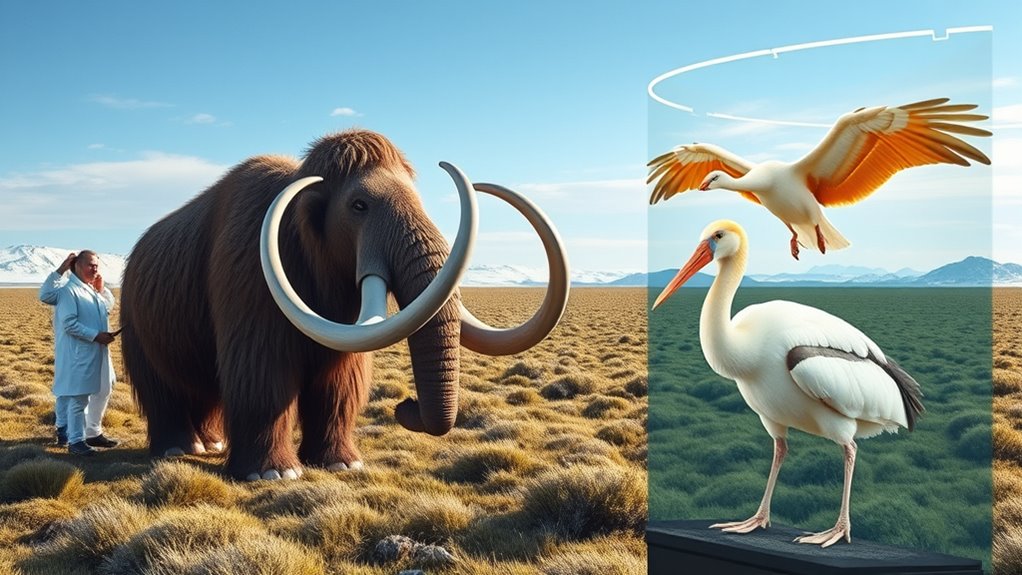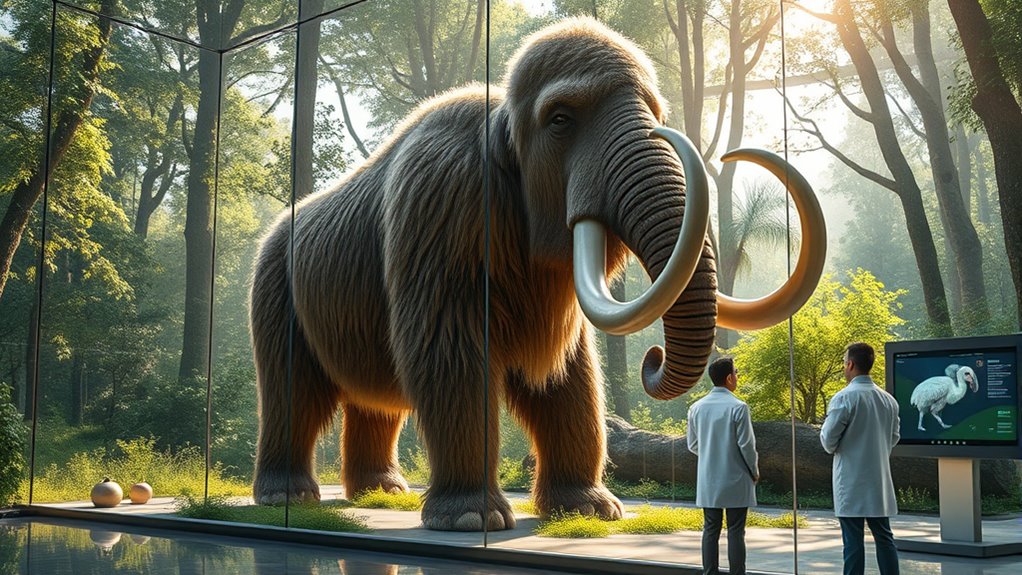Scientists are making great progress in bringing back extinct animals like the woolly mammoth and dodo using advanced genetic engineering techniques such as CRISPR. They insert fragments of DNA from these species into modern relatives or recreate complete genomes, making de-extinction increasingly feasible. These efforts raise ethical questions about ecological impacts and animal welfare. If you want to discover how these cutting-edge techniques could reshape the future of extinct species, keep exploring the fascinating developments in this field.
Key Takeaways
- Advances like CRISPR enable precise genetic editing to potentially revive extinct species such as the woolly mammoth and dodo.
- Researchers are using preserved tissue samples and genome reconstruction to facilitate de-extinction efforts.
- The scientific community is making significant progress toward creating hybrid or fully reconstructed genomes of extinct animals.
- Ethical debates focus on ecological impacts, animal welfare, and resource allocation related to bringing back extinct species.
- Rapid technological developments are making de-extinction increasingly feasible, raising important moral and ecological considerations.

Advances in genetic engineering are bringing the idea of de-extinction closer to reality, allowing scientists to potentially resurrect species once thought lost forever. By manipulating DNA, researchers can now edit genes, insert fragments from extinct animals into living relatives, and even attempt to recreate entire genomes. The concept of bringing back animals like the woolly mammoth or the dodo is no longer just science fiction; it’s an active area of scientific exploration. However, as you explore this groundbreaking field, you must consider the complex ethical considerations that come with it. Restoring extinct species raises questions about ecological balance, animal welfare, and human responsibility. Is it right to interfere with nature in this way? Could reviving these animals cause unforeseen harm to current ecosystems? These are critical issues that scientists, ethicists, and the public are debating as de-extinction technology progresses. Additionally, the rapid advancement of genome editing techniques continually pushes the boundaries of what may soon be possible.
Genetic engineering serves as the core tool enabling these efforts. Techniques like CRISPR-Cas9 allow scientists to precisely edit DNA sequences, which is essential when trying to recreate animals from fragmented or degraded genetic material. For example, by inserting genes from frozen woolly mammoth tissue into the DNA of modern elephants, researchers hope to produce hybrid offspring with mammoth traits. This approach demonstrates how advanced genetic engineering makes de-extinction conceivable, but it also underscores the importance of ethical considerations. You must ask whether it’s responsible to bring back animals that have been extinct for thousands of years. Would these creatures suffer in today’s ecosystems or struggle to survive without their original habitats? Furthermore, there’s concern about the potential ecological disruption, such as competition with existing species or unforeseen impacts on biodiversity. Considering the ethical implications is vital when evaluating the potential success and consequences of de-extinction.
The ethical considerations extend beyond ecological concerns. You should think about the welfare of the revived animals themselves. Would they be able to thrive in a world that has changed since their time? Could they experience suffering or hardship? Additionally, questions of resource allocation arise—spending significant funds on de-extinction projects might divert attention from conserving endangered species that still exist. Public opinion varies, with some viewing de-extinction as a noble pursuit to correct past mistakes, while others see it as an irresponsible gamble with nature. As you follow these developments, it’s essential to weigh the potential benefits of restoring lost species against the moral and ecological risks involved. Moreover, advancements in vetted scientific techniques are continually shaping what is possible in the field of de-extinction. Recognizing the importance of genetic diversity can help guide ethical decisions in this emerging science. Ultimately, the path of de-extinction will require careful consideration of both scientific possibilities and the profound ethical implications that come with re-writing parts of Earth’s history.
Frequently Asked Questions
What Ethical Concerns Surround De-Extinction Efforts?
You should consider the ethical concerns surrounding de-extinction efforts, especially with genetic editing and species revival. These efforts raise questions about playing god, disrupting ecosystems, and prioritizing extinct species over conserving current ones. You might also worry about the welfare of revived animals and whether humans have the right to bring back species that might cause unforeseen ecological consequences. Balancing scientific progress with moral responsibility is vital in this debate.
How Would Revived Species Impact Existing Ecosystems?
You might wonder how revived species could affect ecosystems. If you introduce these species, they could alter genetic diversity and disrupt ecosystem balance. They might compete with native species for resources or change habitat dynamics, leading to unintended consequences. While some may help restore lost functions, others could cause more harm than good. Understanding these impacts is vital to guarantee that reintroductions support, rather than harm, existing ecosystems.
What Are the Potential Risks of De-Extinction Technology?
You should know that de-extinction poses significant risks, like disrupting ecological balance. For instance, reintroducing species with limited genetic diversity could threaten their survival and impact existing ecosystems. If these revived species don’t adapt well, they might outcompete native ones or spread diseases. As tempting as it sounds, you need to contemplate how this technology could unintendedly harm biodiversity and the delicate harmony of natural environments.
Who Funds the De-Extinction Research Initiatives?
You should know that funding sources for de-extinction research include a mix of private investments, government grants, and philanthropic donations. Private investments often come from biotech companies and wealthy individuals interested in scientific breakthroughs and commercial applications. Governments and NGOs also support such projects to explore ecological benefits or conservation. These combined funding sources help accelerate technological development, but they also raise questions about priorities and ethical considerations.
How Soon Could De-Extinct Species Become Part of the Wild?
You might wonder when de-extinct species could join the wild. With advances in genetic engineering, it’s possible within decades, but conservation priorities could slow this process. Scientists need to guarantee these species won’t disrupt ecosystems or divert resources from endangered ones. While technology advances rapidly, ecological and ethical considerations mean it could take 20 to 50 years before de-extinct species are potentially released into the wild, if at all.
Conclusion
As you watch scientists inch closer to bringing back creatures like the woolly mammoth and dodo, it’s clear that de-extinction is no longer just a pipe dream. Their efforts are opening a new chapter where the past and present collide, like two sides of the same coin. But remember, with great power comes great responsibility — this isn’t just a science experiment, it’s a delicate dance on the edge of nature’s balance.









